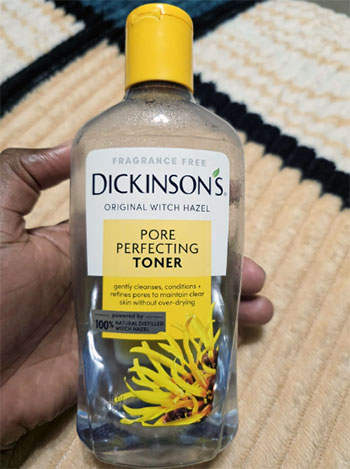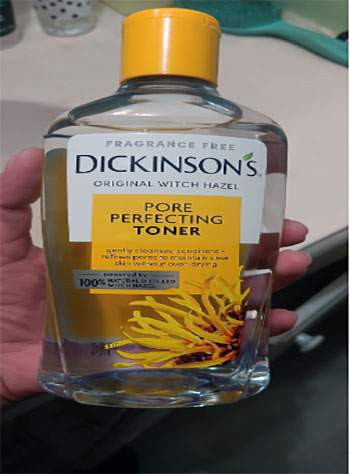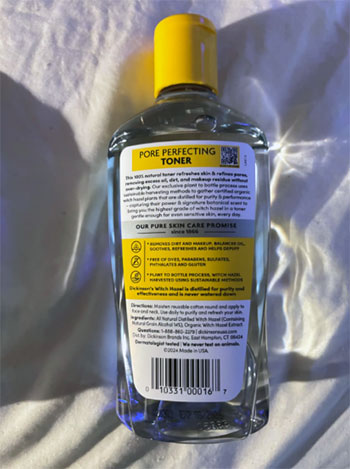I’m not one to gush over skincare products lightly, but Dickinson’s Original Witch Hazel Pore Perfecting Toner has earned its place on my bathroom shelf, and I’m convinced it deserves a spot on yours too.
This isn’t just another toner—it’s a game-changer that cleanses, balances, and refreshes without the fuss or hefty price tag.
At just a few bucks for a generous 16-ounce bottle, it’s a steal that delivers results. Whether you’re battling oily skin, enlarged pores, or just want a clean slate for your serums, this toner’s got your back. Trust me, you’ll want to try it.
My Journey With Dickinson’s Witch Hazel Toner
A few years ago, my skin was a mess—oily in some spots, dry in others, with pesky breakouts that seemed to pop up at the worst times. I’d tried countless cleansers and serums, but nothing quite clicked.
Then, a friend raved about Dickinson’s Witch Hazel Toner, and I figured, why not? It was cheap, natural, and had a cult following. I picked up a bottle at my local drugstore, and that’s when my skincare routine started to shift.

The first time I used it, I was skeptical. The bottle’s no-frills design screamed “old-school,” and the faint, earthy scent of witch hazel wasn’t exactly spa-like. But after swiping it across my face with a cotton pad post-cleansing, I was hooked. My skin felt squeaky clean—not stripped, just pure.
I noticed leftover makeup and grime on the cotton pad that my cleanser had missed, which was both gross and satisfying. Over the next few weeks, my pores looked smaller, my skin felt less oily, and those random breakouts? They started to fade.
What surprised me most was its versatility. Beyond my face, I started using it on my underarms after a reviewer mentioned it helped with odor. Lo and behold, it worked—keeping me fresher for longer without irritation.
I even dabbed it on a postpartum irritation (thanks, OBGYN tip!), and it soothed like magic. This toner wasn’t just a one-trick pony; it was a multi-tasking wizard. Now, it’s a non-negotiable in my daily routine, morning and night, and I always keep a travel-sized version or the wipes for when I’m on the go.
Also Read: My Thoughts On Innisfree Retinol Cica
The Pros Of Dickinson’s Witch Hazel Toner
Pore-Refining Powerhouse
Let’s talk about pores. If you’re like me, you’ve probably spent way too much time staring at your reflection, wishing those little craters would shrink. Dickinson’s toner is like a magic eraser for pores. Its witch hazel base acts as a natural astringent, gently tightening skin and reducing the appearance of pores without that harsh, stripped feeling. After a few weeks of consistent use, I noticed my forehead and nose looked smoother, and my makeup applied more evenly. It’s not just cosmetic either—smaller-looking pores mean less room for dirt and oil to clog things up.
Oil Control Without the Dry-Out
If you’ve got oily or combination skin, you know the struggle of finding a product that controls shine without turning your face into a desert. Dickinson’s strikes that balance perfectly. The 14% alcohol content sounds scary, but it’s grain alcohol from the witch hazel distillation process, not the drying stuff you’d find in harsher toners. I use it twice daily, and my skin stays matte longer without flaking. It’s like it tells my oil glands to chill out without punishing the rest of my face.
Budget-Friendly Brilliance
At around $4–$6 for a 16-ounce bottle, this toner is a steal. You’re getting a product that rivals high-end brands in efficacy, but without the wallet-destroying price tag. One bottle lasts me months, even with daily use, because a little goes a long way. I pour a small amount onto a cotton pad, and it’s enough to cover my face and neck. For the price, it’s hard to find anything that performs this well.

Versatility for Skin and Beyond
This toner isn’t just for your face. I’ve used it to soothe bug bites, calm post-shave irritation, and even freshen up my underarms. The anti-inflammatory and antibacterial properties of witch hazel make it a Swiss Army knife for skin issues. I’ve even heard of people using it to ease postpartum discomfort or treat minor cuts. It’s like having a first-aid kit and skincare product in one bottle.
Gentle Enough for Sensitive Skin
Despite the alcohol content, this toner is surprisingly gentle. I have sensitive skin that flares up with heavy fragrances or harsh chemicals, but Dickinson’s doesn’t irritate. It’s fragrance-free, paraben-free, and uses 100% natural witch hazel, which feels like a breath of fresh air compared to synthetic-heavy products. It soothes redness and doesn’t sting, even on freshly cleansed skin.
The Cons Of Dickinson’s Witch Hazel Toner
The Scent Isn’t for Everyone
Let’s be real—the smell of witch hazel is an acquired taste. It’s earthy, slightly medicinal, and reminds me of a forest after rain mixed with a hint of alcohol. I’ve grown to like it because it feels authentic, but if you’re sensitive to scents, it might take some getting used to. The good news? The smell fades within a minute, so it’s not lingering all day.

Potential Dryness for Some Skin Types
While I find it non-drying, some users with very dry or sensitive skin report it feels too astringent. The alcohol, even at 14%, can be too much for super dry complexions. If your skin leans parched, you might need to follow up with a heavier moisturizer or opt for Dickinson’s alcohol-free variant. I’ve never had this issue, but it’s worth noting if your skin is on the drier side.
Not a Miracle Cure for Acne
Don’t expect Dickinson’s to single-handedly banish severe acne. It’s fantastic for reducing oil and preventing minor breakouts, but for cystic or hormonal acne, it’s more of a helper than a hero. I pair it with a targeted treatment like Epiduo for stubborn pimples, and together they work wonders. On its own, it’s great for maintenance but not a cure-all.
Tips For Using Dickinson’s Witch Hazel Toner
Apply with a Cotton Pad for Best Results
To get the most out of this toner, use a cotton pad. I pour a small amount—about a teaspoon—onto a pad and swipe it gently across my face and neck after cleansing. The pad picks up any leftover makeup, dirt, or cleanser residue, leaving my skin feeling pristine. It’s also a great way to see how much gunk your cleanser missed. Pro tip: Don’t soak the pad; a little product goes a long way.
Use Morning and Night for Consistency
Consistency is key with any toner, and Dickinson’s is no exception. I use it twice daily—after my morning cleanse to prep for serums and sunscreen, and at night to remove any lingering makeup or oil. This routine keeps my skin balanced and my pores in check. If you’re new to toners, start with once a day to see how your skin reacts, then ramp up if it feels good.

Follow with a Moisturizer
Even though it’s gentle, the astringent nature of witch hazel can leave your skin craving hydration. I always follow up with a lightweight serum and moisturizer to lock in moisture. This step is crucial if you have combination or dry skin to prevent any tightness. My go-to is a hyaluronic acid serum followed by a gel moisturizer—it’s like giving my skin a tall glass of water after the toner’s deep clean.
Store Properly to Maintain Potency
Keep your bottle in a cool, dry place away from direct sunlight. I store mine in my bathroom cabinet, and it stays fresh for months. The alcohol content acts as a natural preservative, but heat or humidity can degrade the witch hazel over time. If you’re using the wipes for travel, make sure the pack is sealed tightly to prevent them from drying out.
Patch Test for Sensitive Skin
If you’re prone to irritation, do a patch test before slathering it on your face. I dabbed a bit on my inner arm the first time I used it, just to be safe. No reaction? You’re good to go. This is especially important if you’re trying the alcohol-containing version, as it can be too strong for some.
Comparing Dickinson’s To Other Toner Brands
Thayers Witch Hazel Toner
Thayers is the other big name in witch hazel toners, and I’ve given it a whirl to see how it stacks up. Unlike Dickinson’s, Thayers is alcohol-free, which makes it a gentler option for sensitive or dry skin. It also comes in fun variants like rose petal or cucumber, which smell divine compared to Dickinson’s earthy vibe. However, Thayers’ witch hazel is diluted with water and other ingredients like aloe and glycerin, so it feels less potent. I found it hydrating but less effective at controlling oil or shrinking pores. Plus, Thayers costs more—often double the price for a smaller bottle. If you prioritize scent and gentleness, Thayers might edge out, but for raw efficacy and value, Dickinson’s wins.
Beauty Bakery Witch Hazel Toner
I stumbled across Beauty Bakery’s witch hazel toner at a local store, drawn in by its budget-friendly price. It’s a decent option if you’re pinching pennies, but it falls short of Dickinson’s in performance. Beauty Bakery’s formula feels milder, which is great for sensitive skin, but it didn’t do much for my oily zones or pore size. The scent is nicer—think floral notes—but it takes longer to see results, and it didn’t control breakouts as effectively. For a quick, no-fuss toner that delivers fast, Dickinson’s is the better bet.
Proactiv Toner
Proactiv’s toner was part of my teenage acne-fighting arsenal, but it’s a different beast from Dickinson’s. It’s packed with active ingredients like glycolic acid, which targets acne but can be harsh. I found Proactiv drying and irritating over time, especially compared to Dickinson’s gentle, natural formula. Proactiv is pricier and part of a system, so you’re locked into buying multiple products. Dickinson’s stands alone, offering versatility and affordability without the irritation. If you need heavy-duty acne treatment, Proactiv might suit you, but for everyday toning, Dickinson’s is less aggressive and more wallet-friendly.
Clinique Clarifying Lotion
Clinique’s Clarifying Lotion is a cult favorite for exfoliation, but it’s not a fair fight against Dickinson’s. Clinique uses salicylic acid and alcohol to slough off dead skin, which is great for texture but can be overkill for sensitive skin. I tried it and loved the smoothness but hated the stinging. Dickinson’s is simpler, focusing on cleansing and oil control without the exfoliating bite. Clinique’s price tag is also steep—think $20+ for a smaller bottle. If you want a toner that’s gentle and multi-purpose, Dickinson’s is the way to go.
Read More: My Thoughts On The Inkey List Omega Water Cream
Frequently Asked Questions (FAQ)
Dickinson’s Hydrating Toner, a variant of their classic formula, is designed to cleanse, tone, and lightly moisturize. It uses witch hazel to remove excess oil and impurities while refining pores. Unlike the original, it’s alcohol-free, making it gentler for dry or sensitive skin. It also soothes irritation and preps your skin for serums or moisturizers, leaving it soft and balanced. I find it’s great for adding a touch of hydration without the heavy feel of a cream.
Many dermatologists give witch hazel toners a thumbs-up for their anti-inflammatory and antibacterial properties, especially for oily or acne-prone skin. However, opinions vary. Some praise its ability to reduce oil and redness, while others caution against alcohol-based versions like Dickinson’s original for very dry or sensitive skin. My dermatologist suggested it for my combination skin, and it’s been a staple ever since. Always check with your own derm to ensure it fits your skin’s needs.
Witch hazel toners, like Dickinson’s, aren’t perfect. The alcohol in the original formula can dry out sensitive or dry skin, causing tightness or irritation. The scent, while natural, can be off-putting—earthy and slightly medicinal. It’s also not a cure for severe acne; it’s better for maintenance than tackling deep cystic breakouts. For some, it may not feel “fancy” enough compared to high-end toners with more complex formulas.
Yes, you can use Dickinson’s Witch Hazel Toner daily, as I do, morning and night. It’s gentle enough for most skin types when followed with a moisturizer. However, if you have very dry or sensitive skin, start with once daily to avoid irritation from the alcohol content. The alcohol-free version is a safer bet for daily use if you’re prone to dryness. Listen to your skin—if it feels tight, scale back or switch to the hydrating formula.
Conclusion: Make Dickinson’s Your Skincare Staple
I can’t imagine my routine without Dickinson’s Witch Hazel Toner, and I’m betting you’ll feel the same once you try it. It’s affordable, effective, and versatile, tackling everything from oily skin to post-shave irritation with ease. Whether you’re a skincare newbie or a seasoned pro, this toner’s natural, no-fuss formula delivers results without breaking the bank. Grab a bottle, swipe it on, and watch your skin thank you. It’s not just a product—it’s a little bottle of magic for your daily glow.
